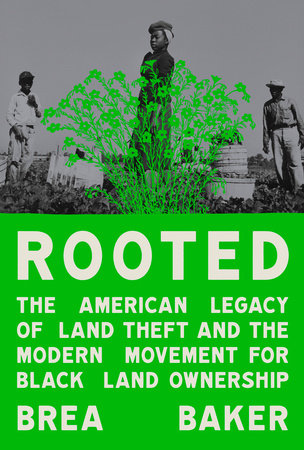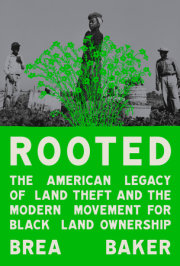Chapter 1In the BeginningWhen I close my eyes, I imagine a world where Black people are joyful and the Earth is safer and thriving. —Leah Thomas
Mother Earth is not a resource, she is an heirloom. —David Ipina, Yurok Tribe
In the beginning, there was the Land and the Land was no one’s because the Land was everyone’s—an extension of us. The Land was living—taking as much as She gave. She spoke to us and we helped to cherish and cultivate Her. She listened, held, and fed us. And when other living things died, the Land took them in. She let the dead help us keep on living and learning, evolving and teaching.
In the beginning, “generational wealth” was the planet and all that She bears. Surplus was an opportunity to lead a happier, healthier life. Everyone had access to the same air, water, and right to housing. That is not to say that certain tribes and communities didn’t succumb to greed but that capitalism was not the normative social order. Before outsiders tried to outsmart the Land, whose wisdom and memory reached further back than theirs, the people learned from and tended the Land, in a loving exchange.
In the beginning, the Americas were just as populated as any other continent. However, the people were far less extractive in their relationship to the land. The first Europeans to cross the Atlantic did not find wilderness. Rather, the eastern coastline of what we now call the United States of America was lined with Indigenous-designed irrigation systems rivaling Venice and terraced fields à la Vietnam, though home to different seeds. Pastures fed herds of bison, which in turn fed the tribes who sustainably hunted them. The coasts of North Carolina made for great fishing, and the (then) forested barrier islands, now known as the Outer Banks, sustained a biodiversity we can only imagine now. Roanoke-Hatteras Algonquin, Chowanog, and Poteskeet peoples filled their bellies with oysters, flounder, and trout, and their communities retained a strong sense of interdependence. Everything and everyone existed in a finely tuned balance, taking as much as they gave.
Scientists in the United Kingdom have studied the impact that European “arrival” to the Americas had on our planet, and it is painfully clear that Earth mourned and suffered the loss viscerally. An estimated 56 million Indigenous people were killed across the Americas—either by these new viruses or the violence committed by those who transported them. Ninety percent of the population that tilled and nourished the land died; and the land did more than rewild. Stone pyramids and temples lay hidden under layers of vegetation. Trees and brush took over. Approximately 55.8 million hectares of land—about one-third of Russia’s landmass—overtook itself and reforested.
The last time Earth went through a period of cooling—in contrast to the global warming we’re currently experiencing—was in the sixteenth and seventeenth centuries, when the decimation of Indigenous populations led to a drastic drop in CO2 levels. It ultimately sent the planet deeper into the Little Ice Age, where northern harbors closed their ports and famines traveled from continent to continent.
When those boats disappeared into the hazy horizon, the Land and Her stewards were already forever changed.
——
The modern concept of private property went against everything Black and Indigenous people knew about life. As Matthew Desmond wrote in his essay on capitalism for The 1619 Project: A New Origin Story, “[Private property] is what enables a private landowner to fence off natural resources and forests and rivers, assets that originally belonged to no one and were stewarded by the surrounding community, transforming common goods into commodities controlled by a single person or business entity.” Land in the Americas had become politicized since the arrival of the first European colonists in the fifteenth century, and that only snowballed into the eighteenth and nineteenth centuries.
Settler colonialism, the violent replacement of Indigenous peoples by (often European) outsiders, created deep inequity as land became a chess piece for the powerful. Access to land meant so much more than purely where you laid your head or where you kept your things. In I’ve Been Here All the While, Dr. Alaina E. Roberts writes, “Native peoples have long established their connection to the lands they occupied . . . through medicinal, food, and spiritual traditions that utilize plants and animals indigenous to the area . . . Removal meant that [Indigenous people] were not only physically uprooted but also spiritually uprooted.” And when it came to Black people, Desmond continues reminding us that “slavery, then, required ‘the magic of property.’ ”
The more land Europeans could push Indigenous people off of, the more demand for forced labor to produce ecologically unsustainable, yet highly lucrative, amounts of cotton, tobacco, rice, and sugarcane.
Men with alabaster skin and bleached worldviews wanted a monopoly on life itself. They literally and figuratively lassoed their surroundings into submission. They did not realize that their existence depended on the health of the entire ecosystem, nor did they understand what Black and Indigenous peoples, no matter which continent we’ve called home, inherently understood—that one’s relationship with the land should be familial, spiritual. Marilyn Berry Morrison, of the Roanoke-Hatteras Tribe, in an interview with the Island Free Press, offered, “Long before conservation efforts were ever dreamed of—or needed—stewardship was simply an innate part of everyday life . . . We lived with nature, and everything that we had came from nature . . . and we were appreciative of that.”
Freedom for both enslaved African people and dispossessed Native Americans relied on alliances against the imperialism that had already transformed the African and American continents. Freedom was community in the face of violent individualism, which makes it no surprise that some of the first acts toward Black liberation were marronage—the art of stealing oneself and building community with other self-liberators—rather than more individualized approaches to getting free. To put it plainly, maroons are escaped Black people, and their descendants, who fled plantations and established new communities just under the noses of their former enslavers. Oftentimes, maroons found refuge with nearby Indigenous tribes and forged a new society together, one that resisted capitalism, white supremacy, anti-Blackness, and anti-Indigeneity. Which is to say that their societies didn’t let the lust for profit get in the way of prioritizing connection: to one another, to the living things all around us, and to the land.
Dr. Neil Roberts, professor and author of Freedom as Marronage, explored the sociological, political, and economic structures underpinning marronage, which he defines in his introduction as “a group of persons isolating themselves from a surrounding society in order to create a fully autonomous community.” He goes on to remind readers that marronage existed across the Americas, in Haiti, Jamaica, the Dominican Republic, Suriname, Venezuela, Cuba, Colombia, and Mexico. In Brazil, where more than 50 percent of the nation’s population is Black, quilombo is the word used to describe rural communities of Black escapees, and over three thousand of them exist to this day. Clébio Ferreira, who founded Quilombaque, a quilombo in the Perus neighborhood of São Paulo, explained why he invests in modern-day marronage: “When we build a quilombo, we are coming together to build a new world.”
Despite being continents away, these maroon, cimarrón, and quilombo societies were structured very similarly: always situated in rural areas, defended through guerilla warfare, spiritually grounded, and noticeably equitable. Before the existence of modern technologies, without ways of knowing and replicating what was transpiring thousands of miles away, maroon communities across the Americas tapped into a common ancestral feeling and let that be their North Star.
Maroon communities were not formed haphazardly, and their intentionality can and should be a beacon for those committing to justice in the twenty-first century and beyond. According to Dr. Neil Roberts, “Marronage is a multidimensional, constant act of flight that involves what I ascertain to be four interrelated pillars: distance, movement, property, and purpose,” with movement being the central principle. Movement, defined as autonomy and control over one’s motion, is an obvious component of freedom for a group of people previously transported against their will to work for others. What made distance, property, and purpose critical is that autonomy and access to land were so interconnected. As Dr. Neil Roberts describes, “Land is a space of cultivation. It is where one can work and rest.”
Copyright © 2024 by Brea Baker. All rights reserved. No part of this excerpt may be reproduced or reprinted without permission in writing from the publisher.






